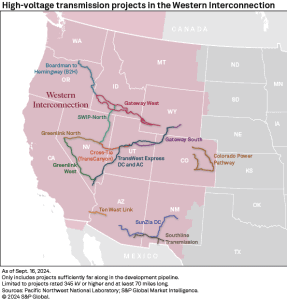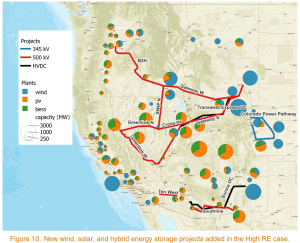Powering the West: How Transmission Projects Can Slash Power-Sector Emissions by 73%
September 25, 2024
The successful completion of 12 high-voltage electric transmission projects in the US West could dramatically reduce the region’s carbon emissions. It can cut power-sector emissions by 73% from 2005 levels by 2030, according to a recent study by the Pacific Northwest National Laboratory (PNNL).
The study underscores the critical role that renewable energy and transmission infrastructure will play in achieving national climate goals, specifically President Biden’s ambition to transition to a 100% carbon-free power system by 2035.
A Holistic Approach to Decarbonization
The 12 transmission projects could unlock over 72 GW of new solar, wind, and battery storage capacity. It can significantly contribute to the region’s decarbonization efforts. Importantly, all of these projects are either in advanced development, under construction, or already operational, making them essential components of the renewable energy expansion in the West.
The study was conducted in connection with the US Department of Energy’s forthcoming National Transmission Planning Study, which seeks to provide insight into regional and interregional grid planning efforts. It predicts a 32% drop in energy generation costs by 2030, assuming the completion of critical transmission projects.
The research, led by Konstantinos Oikonomou of PNNL, analyzes how the 12 new transmission lines across the Western Interconnection, which will add 3,000 miles of capacity, could lower carbon emissions and enhance grid reliability. With this infrastructure, the region could expand its renewable capacity by 35 GW of wind, 31 GW of solar, and 12 GW of energy storage.


In the study, titled the Western Interconnection Baseline Study, PNNL researchers assessed whether the current industry planning processes in the West are aligned with national climate goals. They created a base case using data from the Western Electricity Coordinating Council (WECC). They factored in expected generator additions, retirements, new transmission capacity, and load growth through 2030.
The study then compared this base case with a “high renewables case,” which assumes the completion of 12 high-voltage transmission projects across the region. These projects were selected because they are “sufficiently far along in the development pipeline”. This means that construction is either ongoing or in advanced stages of federal and state permitting.
Unlocking Renewable Potential
One notable project is the Ten West Link transmission line, which began commercial operation in June 2024. Spanning 125 miles, this line is set to deliver over 3 gigawatts (GW) of renewable energy to consumers in California and the Desert Southwest. Owned by Lotus Infrastructure Partners and operated by California ISO, the Ten West Link exemplifies the vital role transmission lines play in decarbonizing the power sector.
Another significant project in the study is the Gateway West project, which stretches 488 miles and is developed by PacifiCorp. This project is specifically designed to transmit wind energy from Wyoming to a substation in Idaho.


From there, the energy will be further transmitted through the Boardman-to-Hemingway transmission line. This nearly 300-mile line is a collaborative effort by Berkshire Hathaway Energy and other partners.
These interconnected projects showcase a coordinated approach to transferring renewable energy from low-density states, like Wyoming and New Mexico, to more densely populated regions throughout the West.
The complementary nature of these projects is essential for ensuring that renewable energy can flow across long distances. This capability is crucial for reducing carbon emissions in large urban centers, as it enables cities to access cleaner energy sources.
Enhancing Grid Reliability with High Renewables
The transition to renewable energy is essential for reducing carbon emissions and achieving a sustainable power grid in the US. However, integrating more renewable sources, like solar and wind, into the grid presents challenges.
Notably, the PNNL study uses a unique modeling approach called alternating current (AC) power flow modeling. This method differs from the more traditional production cost analysis, which primarily focuses on the cost of energy production.
Instead, AC power flow modeling allows researchers to simulate how new renewable energy sources affect the grid. They can identify potential weaknesses and vulnerabilities in the grid when high levels of renewables are integrated.
The study found that the additional high-voltage transmission lines would support 29 GW of new solar capacity, 26 GW of onshore wind, 15 GW of battery storage, and 3 GW of offshore wind.
Additionally, the study assumed that all new solar installations would incorporate 4-hour battery storage with a storage capacity equivalent to 50% of the solar resource’s nameplate capacity. This is a critical feature, as it would make solar and wind energy dispatchable. It means that energy generated by these sources could be stored and used when demand spikes or during periods of low generation.
However, even with these advancements in renewable energy and storage, the study found that some thermal generation capacity may still be required. This is particularly true during the early morning hours when storage systems may not be fully charged or available.
Nader Samaan, a PNNL power systems research engineer and co-author of the study, noted that:
“This could be one of the more challenging periods, where you need to have some thermal generation on your system to help with the morning ramp-up period.”
The completion of the transmission projects represents a significant step toward achieving a carbon-free power system in the US West by 2035. The study highlights the importance of advancing transmission infrastructure to support the nation’s decarbonization goals.
Search
RECENT PRESS RELEASES
Related Post




